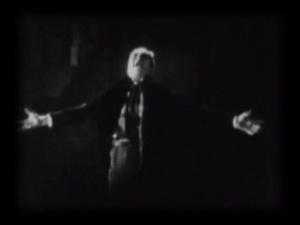
Yes, musical theater fans, it’s time for me to be That Guy: the one who reminds you your favorite play began life as a silent horror movie that continues to define its genre. Which was itself an adaption of a 1909 novel, originally serialized in the French daily newspaper Le Gaulois. Its author, Gaston Leroux, was one of those law students who said, “Fuck the law, I want Meat,” and became a journalist, with a side racket reviewing operas. Inspired by this, and Edgar Allen Poe (like so many French writers of his time) Leroux eventually gave up his journalist gig for the looked-profitable-at-the-time job of writing detective fiction (starring his own Author-Insert Fantasy detective, Joseph Rouletabille) and stories that combined “the fantastic with the real,” as one of the first title cards of this film puts it.
The Phantom of the Opera is the most famous thing to escape Leroux’s head and if you ask a film buff why they’ll point to Lon Chaney Sr. and say, “Feast your eyes and soul on his exquisite make-up job! It’s so damn ugly even the cameraman lost focus for a second.” Together with the high praise he’d already earned for The Hunchback of Notre Dame, this film pushed Chaney’s star into the upper firmament because here, as there, he did his own make-up, like a man. A “Man of a Thousand Faces,” in fact – the moniker by which most fans know him today, whether they’ve seen this film or not.
You can tell which ones haven’t. If they had, there would’ve been far more Phantom of the Opera jokes in everyone’s reviews of the Twilight series. But Phantom‘s one of those films – like Hunchback, or Nosferatu – much talked about and rarely seen outside “Classic Movie” fan circles and the cable channels that are their focal points. The reason being it’s…not really all that. It’s…okay.

And it opens some time after 1875, because the Paris Opera House is complete and it’s become the go-to hang out for people of wealth and taste. So successful is the Palais Garnier that its old owners are selling out, warning the new owners, “that you may hear of a ghost – a Phantom of the Opera.” Said to hold Box Five in the name of a foreigner, the cloaked figure never speaks or shows his face to the attendants. But a young primadona’s understudy, Christine (Mary Philbin), has heard his voice through the walls, believing him to be “the Spirit of Music” incarnate, sent down from Heaven by her dead dad. And haven’t their nightly practice sessions improved her voice? Haven’t the “Spirit’s” teachings powered her rise from the chorus? Did she not set the house afire with her performance as Marguerite in Faust, after prima donna Mme. Carlotta (Virginia Pearson) “mysteriously” fell ill?
Indeed. With her dream achieved, Christine’s beau, the Vicomte Raoul de Chagny (Norman Kerry), insists it’s marryin’ time. All would be well…except the “Spirit” now demands Christine “forget all worldly things and think only of your career – and your Master!” Ah, the old Marriage vs. Career conflict. Would that this weren’t still immediately familiar to every professional woman everywhere. “Soon, Christine, this spirit will take form and demand your love!”
Instead of running for the hills, or questioning the fact she’s literally hearing voices, Christine soldiers on, unaware that her Spirit is sending angry letters to the new owners, demanding she play Margurette full time and warning that “you will perform Faust in a house with a curse on it” , if she doesn’t, Robbed of basic human curiosity, Christine becomes the kind of heroine who’ll willingly step through the secret passage behind her dressing room mirror – even after the Opera’s seven-ton bronze chandelier crashes into the front rows, reducing their occupants to paste. Immediately after that, in fact. What’s a few seats full of dead people when you’re in lust with an imaginary friend?
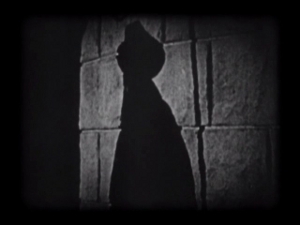 Well, what if your friend is best left imaginary? Christine’s Spirit turns out to be a masked man living a lonely life in the cavernous catacombs beneath the Opera. Spiriting her away, first on a horse, then on a gondola (shades of Charon and the River Styx), the Phantom brings her home and tries to impress her with his organ (playing) and the coffin that is his bed (shades of the vampire?). He implores her not to touch his mask…which, of course, she does, in one of the most famous scenes in Horror Movie history. (A phrase I know I’m going to get sick of typing long before I get sick of reviewing these Classics.) Who is this masked man? What drove him underground? And why is he so obsessed with this flighty chorus girl? Who the hell mistakes a voice from walls for the Spirit of Music anyway? I’ve got six of the damn things howling at me right now, but the strategic deployment of a few rum & Cokes always shuts them up….there? See? Gone.
Well, what if your friend is best left imaginary? Christine’s Spirit turns out to be a masked man living a lonely life in the cavernous catacombs beneath the Opera. Spiriting her away, first on a horse, then on a gondola (shades of Charon and the River Styx), the Phantom brings her home and tries to impress her with his organ (playing) and the coffin that is his bed (shades of the vampire?). He implores her not to touch his mask…which, of course, she does, in one of the most famous scenes in Horror Movie history. (A phrase I know I’m going to get sick of typing long before I get sick of reviewing these Classics.) Who is this masked man? What drove him underground? And why is he so obsessed with this flighty chorus girl? Who the hell mistakes a voice from walls for the Spirit of Music anyway? I’ve got six of the damn things howling at me right now, but the strategic deployment of a few rum & Cokes always shuts them up….there? See? Gone.
When I called Phantom of the Opera “okay” I mean the film, obviously. The book has its own problems, which Adaption Decay dutifully magnified. The characters were purposefully archetypal, and omitting most of their backstories flattens them even further. As characters, they’re thin crusts, and this only aids the Phantom. We need him to be an alluring mystery because that’s how Christine sees him. That allure must turn to dread in time with Christine’s own. It does, and that’s why the Unmasking’s so damn memorable. That, and the expression on the Phantom’s face. What, you’re honestly that surprised? Guess he never figured out telling a girl “Don’t do X” is tantamount to wiring your secret base’s self-destruct bomb to a big, red button that reads “Do Not Press.” So there’s one benefit of the modern, co-ed public school systems: most of us learn that before we escape Kindergarten.
Horrified by his ugliness, Christine pleads to go, promising “I will be your slave forever.” Being a moron, the Phantom allows her to return topside for one last performance, on the condition she tell Raoul to fuck off and die. Instead, she sends a letter to Our Designated Hero, with plans meet up at the annual Bal Masque de l’Opera. If the Unmasking scene is this film’s most famous, the Masque scene would be a close second if, like so many things, I didn’t have to wait until I got the internet before I even heard about it.
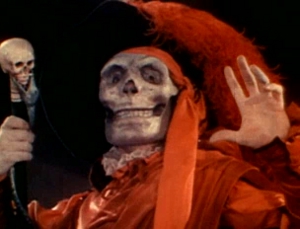 We’re trained to think color was some sudden Great Leap Forward, ignoring things like the use of tinting, the vagaries of projectionists, and the decades of experimentation behind the Big Name successes like The Wizard of Oz or Gone with the Wind. Then, as now, the same forces of showmanship-for-its-own-sake drove filmmakers to augment their stories with spectacular gimmicks. Like the twenty minutes of color footage supposedly present in this film’s original run, shot in an early variant of Technicolor called Process-2.
We’re trained to think color was some sudden Great Leap Forward, ignoring things like the use of tinting, the vagaries of projectionists, and the decades of experimentation behind the Big Name successes like The Wizard of Oz or Gone with the Wind. Then, as now, the same forces of showmanship-for-its-own-sake drove filmmakers to augment their stories with spectacular gimmicks. Like the twenty minutes of color footage supposedly present in this film’s original run, shot in an early variant of Technicolor called Process-2.
Shot two strips of black-n-white film – one behind a green filter, one behind a red one. Add complimentary colors by soaking them in chemical toner. Set aside to dry, then glue to two strips together, one on top of the other. The results will speak for themselves. Blues and greens might be a little hard to distinguish, but human skin will look damned close to how it should…even if the final results look like they were shot on a world where the Red Death (Chaney again) holds sway over all.
If you can, find a version of The Phantom with its colors intact (like the Blu Ray). Apparently, the scenes from Faust were originally colorized as well (providing an excuse to colorize the two Big moments from the film’s first hour), but time’s destroyed that footage, along with the original 35mm print and many, many, many other films. Including most of Chaney’s pre-Hunchback career, sadly. Find a tinted print if you can’t find the colored one – the colors provides a nice distraction from the boring characters and the double-bind of forbidden love they’re trapped in.
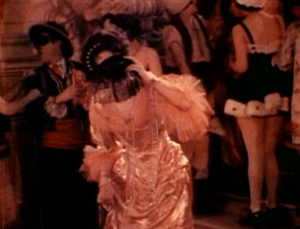
As little as I like the novel, at least it added some dimension to these excuses for humanity. The Phantom of the novel – identified as “Erik,” though we never truly learn his birth name, do we? – was a musical and architectural prodigy who built himself a subterranean lair to escape the casual cruelties of human life, which he experienced first hand from…well, pretty much everyone. The parents who abandoned him. The patrons of the Gypsy circus who gave him his first job. The rulers of Persia and Turkey (!) who contracted his services and kept trying to kill him once his jobs were done. Fuck all of ’em – best go live in the sewers and work on your Don Juan. At least down there, the rats can’t lie to you, and you know they’re rats on sight.
The Phantom of this movie is an escaped “criminal [sic] insane” prisoner from Devil’s Island, and known “master of Black Art.” I guess there is an art to strangling people, especially if you use knots named after regions of India. But when did running real fast through secret passageways become a “Black Art” in its own right? Better question – why does Erik need to be labeled “criminal insane”? Because he’s a murderous monster? Is he not also a poor, downtrodden, facially-challenged man? Would he not bleed if you pricked him? And was he not imprisoned “within the torture chambers” under the Opera House during “the Second Revolution”?
Like the operas Leroux spent at least ten years reviewing, Phantom‘s characters are meant to be Romantic reconstructions of popular archetypes. Novel Christine and Novel Raoul were childhood love interests separated by social class and a society that still cared about marrying “up.” (Yeah, right, like ours doesn’t….) Hence their not getting hitched until Christine’s “the toast of Paris.” Movie Christine and Raoul are Designated Love Interests from frame one (unless you’re watching a version where their first scene’s moved back behind the Sale of the Opera scene) and I’ll be damned if I can see why, aside from the obvious “they look good together” factor. Raoul’s a brick in a succession of good suits and Christine’s even more naive and less active than her Novel-self. Novel Christine attempted to escape the Phantom’s clutches (eventually resorting to suicide attempts, but hey – that’s melodrama). Movie Christine can’t wait to throw herself into Raoul’s arms and be all, like “-oh save me!” No, dear, save me. From you.
 So everyone got gutted, their motivations whittled down to dust. The one character who knew Erik in his pre-Phantom life is replaced with a Secret Policeman, Ledoux (Arthur Edmund Carewe), who just so happens to’ve figured out Erik’s shtick after months of snooping around, barely noticed by anyone. The film plays cute with this, trying to paint Ledoux as The Phantom in Disguise, but abandons any pretensions of tension-building long before its time for Ledoux to dump his expository load and become Raoul’s deus ex machina, leading him to the Phantom’s lair, Christine, and the climax.
So everyone got gutted, their motivations whittled down to dust. The one character who knew Erik in his pre-Phantom life is replaced with a Secret Policeman, Ledoux (Arthur Edmund Carewe), who just so happens to’ve figured out Erik’s shtick after months of snooping around, barely noticed by anyone. The film plays cute with this, trying to paint Ledoux as The Phantom in Disguise, but abandons any pretensions of tension-building long before its time for Ledoux to dump his expository load and become Raoul’s deus ex machina, leading him to the Phantom’s lair, Christine, and the climax.
Again, Adaption Decay (and the three bad test screenings that led to multiple re-shoots) missed the essential point of the climax, where Erik finally grows the fuck up and realizes Stockholm Syndrome is no basis for a relationship. Some phantoms are capable of this, even without the intervention of their time-traveling children, but Movie Phantom’s been coded as a Monster, and we all know how monsters must be destroyed, right? Torch-wielding mob, I choose you! And I can’t really fault these filmmakers for choosing likewise.
Nor can I fault generations of fans for lionizing Chaney’s performance. As the one person not playing to type, Chaney was free to chew all scenery he could fit through those false teeth. His gestures are broad, expansive – genuinely theatrical in a way his co-stars are not. He dominates every frame, even if his shadow isn’t falling on a nearby wall – even when he isn’t perched on a statue, cape billowing in a manner that would inspire comic book artists (as of this writing, I’m thinking of Todd McFarlane in particular, as well as most of Batman’s artists) for the next century and change. His monstrosity is the source of his power, even if it has reduced him to the literally-lowest point of his society. He revels in what we should consider a source of shame, right up until the true climax. And this is why we root for him. As Larry Cohen told the makers of Nightmares in Red White and Blue,
“I love that moment in Phantom of the Opera where the crowd has got him cornered by the river and he turns to them and he raises his hand, like he’s got something in his hand to throw at them. And they recoil and then he opens his hand…and he’s got nothing in his hand…But I just love that moment…not only does he open his hand but the look on his face, ya know – like ‘Ah-ha! I fooled you!’”
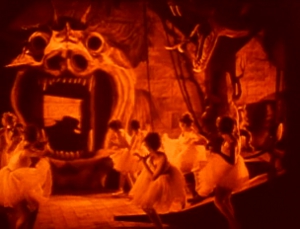
Right on, Lawrence.
As a Designated Classic, I’m supposed to give this full marks by virtue of its copyright date and the sheer glut of films that took cues from its direction and stage design. That’s what Ebert did in his 2004 review, writing “in its fevered melodrama and images of cadaverous romance, it finds a kind of show-biz majesty.” Translation: “the sets were real purtty”. And they are, despite being peopled with ugly dummies who only serve to make the “monster” look better. At least Erik has some passion, some fire in his soul, plainly expressed through three great ways to say, “I love you”: murder, kidnapping and the torture of your romantic rivals.
But, like that adaption of Dr. Jekyll and Mr. Hyde Famous Players-Lasky made five years earlier, this Phantom takes too much inspiration from the Victorian stage and not enough from its own source material. If you can, find the 96 minute cut with the color sequences restored. There’s even some dubbed-in singing in that version, based as it is off a 1930 re-release. By then, “the talkie craze” had seized urban audiences across the country, and anything with sound in it automatically did well at the box office. Universal, having made $2 million off Phantom’s initial run, ordered Ernst Laemmle (nephew of Universal founder and Phantom producer Carl Laemmle) to reshoot half the film with sound. That print’s also lost to us, sadly. And despite the soundtrack’s miraculous survival, it’s impossible to sync those words up to what film we have, since talkies were photographed (and played back) so many frames faster than the silents.
However, we’re all living in the world that 1930 color-and-sound re-release built. It made another million during its run, convincing Universal that talkie horror films were actually profitable, no matter how many critics sneered or how hard the Catholic Defense League protested. Laemmle spent the rest of the year preparing to adapt another famous Gothic thriller, dripping with Capital-R, Romance: Bram Stoker’s Dracula. And we all know how that turned out, don’t we?
![]()
![]()
![]()
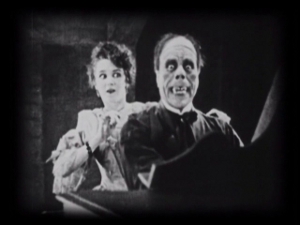

You’ve reminded me that I still haven’t seen this so I’ve just reserved a copy from my local library. Having a great classic be just okay doesn’t usually disappoint me. I pretty much watch every movie with the expectation that it will probably suck. Setting the bar low means I usually enjoy the movie. Nothing is ever as bad as my imagination tells me it could be.
I did enjoy reading the original novel, in part, because I was surprised by pulp villainy of Erik. He’s not just some tragic scarred composer as in modern versions of the story, he’s a freak with his own underground island lair. Somehow I find that more sympathetic than the current incarnation.
Having their own lair always increases a character’s ambient awesomeness, which naturally increases audience sympathy. Especially since we’re so awesome, despite our underground lairs not being anywhere near as cool.
Just finished watching the movie. Yeah, Raoul and Christine are pretty useless. And that was one of the most impressive torch bearing mobs I’ve seen in any horror movie. They were much scarier than poor Erik.
You said it, brother. Testify.